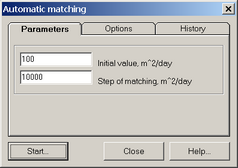The "Automatic matching" dialog box allows estimating the aquifer parameters by solving the inverse problem using least squares regression. The dialog box opens from the main menu "Analysis > Inverse solution > Least-squares method" or function key F8.


"Automatic matching" dialog boxes.
Explanatory table
"Parameters" tab |
Settings for parameter matching. The matching step is assumed |
|
"Initial value" text box |
Initial hydraulic diffusivity value |
|
"Step of matching" text box |
Initial step for matching |
|
"Leakage factor" text box |
For leaky aquifers only. Assumed value of leakage factor for parameters matching |
|
"Options" tab |
"Reduce the step" text box |
Determines the coefficient of matching step reduction if convergence is achieved |
"History" tab |
Fixes the matched values |
|
"Start" button |
Switches to parameters matching |
All the calculation processes are directly displayed in the "Window for auto-matching"

Window of auto-matching.
Explanatory table
"Continue" button |
Continue the matching process with a new step (See "Reduce the step" text box |
"End" button |
Return to "Automatic matching" dialog box |
a |
hydraulic diffusivity current value for convergence search |
f |
the target function value (zero-crossing point of the function is looked for) |
da |
time step |
Since the whole process is displayed, the user can decide to reiterate the process with a different matching step. It is advised not to select excessively small time steps.
If convergence cannot be achieved, use ESC key to manually abort the process. Possible ways to achieve convergence:
1) edit the starting parameters for matching,
2) remove incorrect measurements (see data viewing) or measurements that are obviously not fitting with the chosen model,
3) select another conceptual model.
If the convergence is achieved, but solving the direct problem (see parameters matching) with the matched parameters results in drawdowns dramatically different from observations, it is advised to follow the above procedure again.